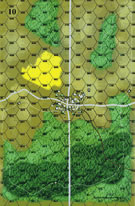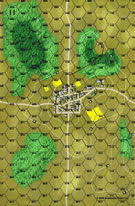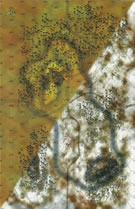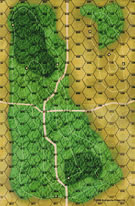|
Diversion Go for Broke #18 |
||
|---|---|---|
| (Defender) Germany | vs | United States (Attacker) |
| Formations Involved | ||
|---|---|---|
| Germany |  |
716th Infantry Division |
| United States |  |
143rd "Third Texas" Infantry Regiment |
| United States |  |
36th "Texas" Infantry Division |
| United States |  |
753rd Tank Battalion |

|
| Overall Rating, 1 vote |
|---|
|
4
|
| Scenario Rank: --- of 940 |
| Parent Game | Go for Broke |
|---|---|
| Historicity | Historical |
| Date | 1944-10-15 |
| Start Time | 08:00 |
| Turn Count | 22 |
| Visibility | Day |
| Counters | 81 |
| Net Morale | 1 |
| Net Initiative | 2 |
| Maps | 4: 10, 11, 25, 9 |
| Layout Dimensions | 86 x 56 cm 34 x 22 in |
| Play Bounty | 176 |
| AAR Bounty | 171 |
| Total Plays | 1 |
| Total AARs | 1 |
| Battle Types |
|---|
| Inflict Enemy Casualties |
| Urban Assault |
| Conditions |
|---|
| Hidden Units |
| Off-board Artillery |
| Severe Weather |
| Scenario Requirements & Playability | |
|---|---|
| Battle of the Bulge | Maps |
| Elsenborn Ridge | Counters |
| Go for Broke | Base Game |
| Introduction |
|---|
|
Unlike the Nisei who were expected to take their objectives in the Bruyeres operation with minimal assistance, the other elements of the 36th Texas Division were sent into combat with plenty Regiment was tasked to confuse the enemy as to the division's true intentions at Bruyeres, and support the main effort to the north by advancing on Bruyeres along Highway D-44 from the southwest. Once they reached Laval they were to swing east along a secondary road and take Champ-le-Duc. The heavy fog and rain allowed them to assemble and begin their advance unobserved but prevented their planned air cover. |
| Conclusion |
|---|
|
The advance on Laval proved costly but eventually numbers and firepower told the tale as the Texans captured the town. Following the plan, the 143rd then swung east to roll up the Germans and force their way into Champ-le-Duc. This effort proved for naught as the depleted Texans ran into frustrated and determined Germans who refused to yield further, and advance faltered. Although this diversion delivered more gains than expected, the Nisei to the north were stymied by weather, and the same stubborn resistance. |
| AFV Rules Pertaining to this Scenario's Order of Battle |
|---|
|
| 3 Errata Items | |
|---|---|

|
The reduced direct fire value of the Heer HMG became 5-5 starting with Fall of France. (plloyd1010
on 2015 Jul 31)
|

|
The morale and combat modifiers of German Sergeant #1614 should be "0", not "8". (Shad
on 2010 Dec 15)
|

|
The movement allowance on the counters in Airborne is misprinted. It should be "3." (rerathbun
on 2012 Jan 30)
|
| Excessive Losses | ||||||||||||
|---|---|---|---|---|---|---|---|---|---|---|---|---|
For several years I indulged myself in a study of the American Civil War. I read incessently and visited battlefields, learning about the use of terrain for the direct fire weapons of that era. It was a very enjoyable time. Much of what has been written is relatively dry stuff (I find Sears to be one of the better writers of history, Foote is very entertaining but many indicate that he falls short on the history side of things), but one quote still sticks in my mind. I believe it had to do with the battlefield at Antietam after the battle. Losses were terrible and the dead covered the ground. One of the witnesses indicated that you could not walk without stepping on a body. This scenario was kind of like that. A battalion of Germans is charged with defending two towns from two battalions of Americans. Both sides have significant artillery resources and a plethora of heavy weapons and engineers. The Americans even have some tanks. With the firepower wielded by the Americans you would expect that they could avoid losses and just stand off and hammer the Germans until they ran. Unfortunately the weather is extremely misty and visibility varies but is generally pretty bad, forcing the Americans to close in on the Germans in order to shoot at all. This gives the Germans (who also have some hidden units) the opportunity to cause significant losses to the Americans as they close in. The key town is Laval which is the larger of the two. The Germans recognize that this is the prize and put very few units in the smaller town. The ambushes work perfectly and the Americans take horrendous losses but eventually their greater numbers overwhelm the Germans and an American win is secured. By turn 14 the score was 47-36 in favor of the Americans and the Germans had only one hex in Laval contested and very few troops at all remaining on the board. The key for the Germans is to keep the Americans at arm's length as once they move into assaults they are doomed as they have lower morale and lower firepower in general. The play followed the historical pattern as the Americans didn't even try to move east after securing Laval, they were seriously disorganized and would have had to try a rush to assault. Better to lick your wounds and reorganize than to go off after 100 Germans who will probably leave on their own shortly. The combination of the weather and the firepower made this one very interesting. I give it a "4". |
||||||||||||
| 0 Comments |

 GofB017
GofB017 


























